新概念第3册第42课ppt
- 格式:ppt
- 大小:221.00 KB
- 文档页数:57
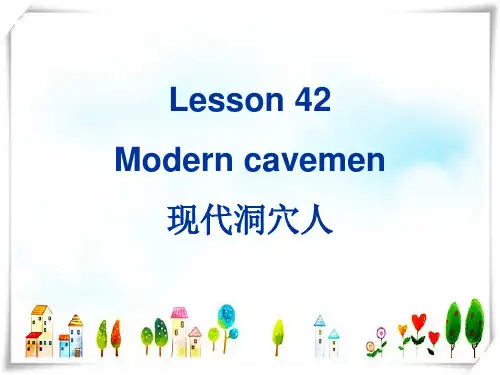
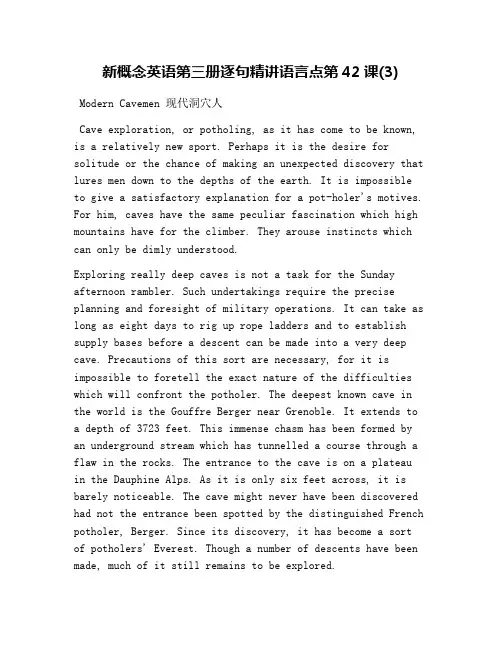
新概念英语第三册逐句精讲语言点第42课(3)Modern Cavemen 现代洞穴人Cave exploration, or potholing, as it has come to be known, is a relatively new sport. Perhaps it is the desire for solitude or the chance of making an unexpected discovery that lures men down to the depths of the earth. It is impossible to give a satisfactory explanation for a pot-holer's motives. For him, caves have the same peculiar fascination which high mountains have for the climber. They arouse instincts which can only be dimly understood.Exploring really deep caves is not a task for the Sunday afternoon rambler. Such undertakings require the precise planning and foresight of military operations. It can take as long as eight days to rig up rope ladders and to establish supply bases before a descent can be made into a very deep cave. Precautions of this sort are necessary, for it is impossible to foretell the exact nature of the difficulties which will confront the potholer. The deepest known cave in the world is the Gouffre Berger near Grenoble. It extends to a depth of 3723 feet. This immense chasm has been formed by an underground stream which has tunnelled a course through a flaw in the rocks. The entrance to the cave is on a plateauin the Dauphine Alps. As it is only six feet across, it is barely noticeable. The cave might never have been discovered had not the entrance been spotted by the distinguished French potholer, Berger. Since its discovery, it has become a sort of potholers' Everest. Though a number of descents have been made, much of it still remains to be explored.A team of potholers recently went down the Gouffre Berger. After entering the narrow gap on the plateau, they climbed down the steep sides of the cave until they came to a narrow corridor. They had to edge their way along this, sometimes wading across shallow streams, or swimming across deep pools. Suddenly they came to a waterfall which dropped into an underground lake at the bottom of the cave. They plunged into the lake, and after loading their gear on an inflatablerubber dinghy, let the current carry them to the other side. To protect themselves from the icy water, they had to wear special rubber suits. At the far end of the lake, they cameto huge piles of rubble which had been washed up by the water. In this part of the cave, they could hear an insistent booming sound which they found was caused by a small water-spout shooting down into a pool from the roof of the cave. Squeezing through a cleft in the rocks, the potholers arrived at an enormous cavern, the size of a huge concert hall. After switching on powerful arc lights, they saw great stalagmites—some of them over forty feet high--rising uplike tree-trunks to meet the stalactites suspended from the roof. Round about, piles of lime-stone glistened in all the colours of the rainbow. In the eerie silence of the cavern,the only sound that could be heard was made by water which dripped continuously from the high dome above them.9.Precautions of this sort are necessary, for it is impossible to foretell the exact nature of the difficulties which will confront the potholer.作出这样的准备是必要的,因为无法预见到洞穴探险者究竟会遇到什么性质的困难。
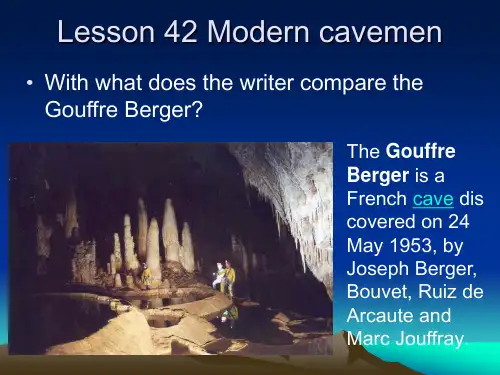
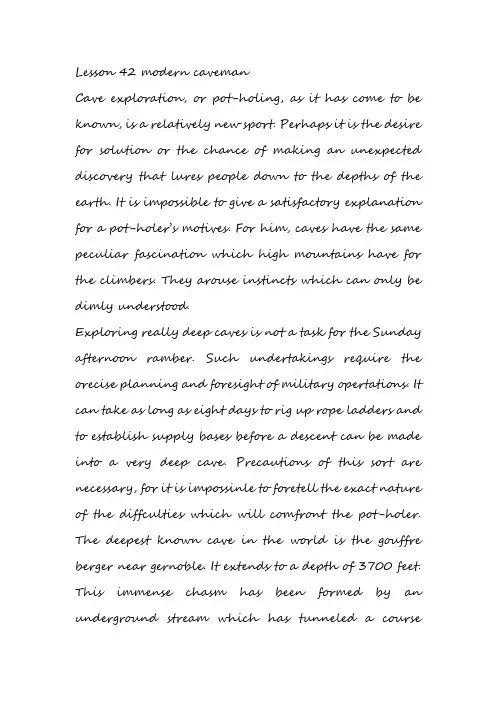
Lesson 42 modern cavemanCave exploration, or pot-holing, as it has come to be known, is a relatively new sport. Perhaps it is the desire for solution or the chance of making an unexpected discovery that lures people down to the depths of the earth. It is impossible to give a satisfactory explanation for a pot-holer’s motives. For him, caves have the same peculiar fascination which high mountains have for the climbers. They arouse instincts which can only be dimly understood.Exploring really deep caves is not a task for the Sunday afternoon ramber. Such undertakings require the orecise planning and foresight of military opertations. It can take as long as eight days to rig up rope ladders and to establish supply bases before a descent can be made into a very deep cave. Precautions of this sort are necessary, for it is impossinle to foretell the exact nature of the diffculties which will comfront the pot-holer. The deepest known cave in the world is the gouffre berger near gernoble. It extends to a depth of 3700 feet. This immense chasm has been formed by an underground stream which has tunneled a course through a flaw in the rock. The entrance to the cave is on a plateau I the Alps. As it is only 6 feet across, it is barely noticeable. The cave might never have been discovered had not the entrance been spotted by thedistinguished french pot-holer, Berger. Since its discovery it has become a sort of pot-holer’s everst. Thought a number of descents have been made, much of it still remains to be explore.A team of pot-holers recently went down the GB. After entering the narrow gap on the plateau, they climbed down the steep sides of the cave until they came to a narrow corridor. They had to edge their way along this, sometimes wading across shallow streams , or swimming across deep pools. Suddenly they came to a waterfall which dropped into an underground lake at the bottom of the cave. They plunged into the lake,and after loading on an inflatable rubber dinghy, let the curret carry them to the other side. T o protect themselves from the icy water, they have to wear special rubber suits. At the far end of the lake, they came to huge piles of rubble which had been washed up by water. In this part of the cave, they could hear an insistant booming sound which they found was caused by a small waterspout shooting down into a pool from the roof of the cave. Squzzing through a cleft in the rocks, the pot-holers arrived in an enormous carven, the size of a huge concert hall. After switching on powerful arc light, they saw salagmites-sime of them over forty feet high- rising up like tree trunks t meet the stalactites suspended from the roof. Round about, piles of limestone glistened in all the colors of the rainbow. In theeerie silence of the carven, the only sound could be heard was made by water which dripped continuously from the high dome above.Jan 30th。

新概念三第42课原文摘要:1.新概念第三册第42 课的内容概述2.文章主题:现代洞穴人3.作者对洞穴探险的看法4.比较戈夫雷·贝格与洞穴探险的关系5.洞穴探险的现状与发展正文:新概念第三册第42 课的内容概述新概念第三册第42 课是一篇关于现代洞穴人的文章。
文章主要讲述了作者对洞穴探险的看法,以及比较了戈夫雷·贝格与洞穴探险的关系。
同时,也探讨了洞穴探险的现状与发展。
文章主题:现代洞穴人本文的主题是现代洞穴人。
洞穴探险,又称作洞穴勘探,是指进入地下洞穴进行探险、研究或开发的活动。
现代洞穴人,指的是那些热衷于洞穴探险的人。
他们通过洞穴探险,不仅可以了解洞穴的地质结构,还可以发现洞穴中的生物、植物等方面的知识。
作者对洞穴探险的看法作者认为,洞穴探险是一项非常有意义的活动。
首先,洞穴探险可以满足人们对未知的好奇心。
在洞穴中,人们可以发现许多奇怪的岩石、洞穴生物等,这些都可以激发人们的好奇心。
其次,洞穴探险可以锻炼人的意志和勇气。
在洞穴中,人们需要面对黑暗、寒冷、潮湿等恶劣的环境,这对于锻炼人的意志和勇气非常有帮助。
比较戈夫雷·贝格与洞穴探险的关系作者通过比较戈夫雷·贝格与洞穴探险的关系,来说明洞穴探险的重要性。
戈夫雷·贝格是法国著名的洞穴探险家,他在洞穴探险方面有着丰富的经验。
作者认为,戈夫雷·贝格的洞穴探险经历,可以为人们提供许多有关洞穴探险的知识和技巧。
洞穴探险的现状与发展目前,洞穴探险已经成为一项越来越受欢迎的活动。
随着科技的发展,洞穴探险的设备和工具也在不断改进。
例如,现在有了更好的头灯、更耐用的绳索、更先进的导航设备等。
这些都为洞穴探险提供了更多的保障。
此外,洞穴探险也逐渐成为了一项专业的活动。
许多洞穴探险团队都会定期进行培训和演练,以提高洞穴探险的安全性和效率。
总之,新概念第三册第42 课讲述了作者对现代洞穴人的看法,以及洞穴探险的现状与发展。

Lesson 42 Modern cavemenNew words and expressionscaveman (远古)洞穴人pot-holing 洞穴探险,洞穴探险运动solitude 孤独,寂寞; loneliness, lonesomelure 引诱,诱惑; seduce, temptpot-holer 洞穴探险者ramble 漫步者,散步者undertaking 任务,工作; task, work, missionforesight 预见,深谋远虑foretell 预言; predict, forecastGrenoble 格里诺布尔chasm 断层,裂口,陷坑; gapflaw 小裂缝; fissuredistinguished 杰出的,著名的, famous, out-standingEverest 珠穆朗玛峰wade 涉水,趟水waterfall 瀑布gear 一套用具inflatable 可充气的rubble 碎石,瓦砾insistent 连续的,不断的boom 轰响waterspout 强大的水柱cleft 裂隙,开口cavern 大洞穴stalagmite 石笋stalactite 钟乳石limestone 石灰石glisten 闪烁; glow, shine, glittereerie 引起恐惧的,可怕的dome 穹窿,圆顶; vault, vt, 加穹顶于(tent)Text1. Cave exploration, or pot-holing, as it has come to be known, is a relatively new sport.as it has come to be known, 插入语,正如已逐渐为人所知的那样,2. Perhaps it is the desire for solitude or the chance of making an unexpected discovery that lures people down to the depths of the earth.It is…that…强调句式。

Modern Cavemen 现代洞⽳⼈Cave exploration, or potholing, as it has come to be known, is a relatively new sport. Perhaps it is the desire for solitude or the chance of making an unexpected discovery that lures men down to the depths of the earth. It is impossible to give a satisfactory explanation for a pot-holer's motives. For him, caves have the same peculiar fascination which high mountains have for the climber. They arouse instincts which can only be dimly understood. Exploring really deep caves is not a task for the Sunday afternoon rambler. Such undertakings require the precise planning and foresight of military operations. It can take as long as eight days to rig up rope ladders and to establish supply bases before a descent can be made into a very deep cave. Precautions of this sort are necessary, for it is impossible to foretell the exact nature of the difficulties which will confront the potholer. The deepest known cave in the world is the Gouffre Berger near Grenoble. It extends to a depth of 3723 feet. This immense chasm has been formed by an underground stream which has tunnelled a course through a flaw in the rocks. The entrance to the cave is on a plateau in the Dauphine Alps. As it is only six feet across, it is barely noticeable. The cave might never have been discovered had not the entrance been spotted by the distinguished French potholer, Berger. Since its discovery, it has become a sort of potholers' Everest. Though a number of descents have been made, much of it still remains to be explored. A team of potholers recently went down the Gouffre Berger. After entering the narrow gap on the plateau, they climbed down the steep sides of the cave until they came to a narrow corridor. They had to edge their way along this, sometimes wading across shallow streams, or swimming across deep pools. Suddenly they came to a waterfall which dropped into an underground lake at the bottom of the cave. They plunged into the lake, and after loading their gear on an inflatable rubber dinghy, let the current carry them to the other side. To protect themselves from the icy water, they had to wear special rubber suits. At the far end of the lake, they came to huge piles of rubble which had been washed up by the water. In this part of the cave, they could hear an insistent booming sound which they found was caused by a small water-spout shooting down into a pool from the roof of the cave. Squeezing through a cleft in the rocks, the potholers arrived at an enormous cavern, the size of a huge concert hall. After switching on powerful arc lights, they saw great stalagmites—some of them over forty feet high--rising up like tree-trunks to meet the stalactites suspended from the roof. Round about, piles of lime-stone glistened in all the colours of the rainbow. In the eerie silence of the cavern, the only sound that could be heard was made by water which dripped continuously from the high dome above them.15. The cave might never have been discovered had not the entrance been spotted by the distinguished French potholer, Berger.若不是法国洞⽳探险家伯杰由于偶然的机会发现了这个洞⼝的话,这个洞也许不会为⼈所知。

Lesson 42 Modern cavemen一、单词讲解New words and expressionscaveman n 洞穴人(穴居人)cave n.洞穴(天然的)caveman n. (远古)洞穴人 a man living in a cave thousands of years agocavern ['k?v(?)n] n. 大洞穴,大山洞 a large cavecavity ['k?v?t?] n.洞,腔(正式的医学术语);(龋齿的)洞pothole ['p?th??l] n.锅穴(冰原),壶穴(河床)(地质)potholing n.洞穴探险(运动)potholer n.洞穴探险者solitude ['s?l?tju:d] n.孤独、寂寞( 2.独处)(enjoying being alone, being without companions)六级罕见live in solitude 独自(居住)生活isolation n.隔离、孤立(不情愿地,被动)(a feeling of being lonely and unable to meet or speak to other people)eg. Retirement can often cause feeling of isolation.seclusion [s?'klu:?(?)n] n. 隔离(主动,隔离室等);隐居、与世隔绝独处(刻意)eg. The Emperor lived in seclusion behind the walls of the Forbidden City.Recluse [r?'klu:s] n.隐士n. 隐士;隐居者adj. 隐居的远离【世界】,过着【隔绝】生活,“常常”是【独处】。
- 不一定是【宗·教·信·仰】的原因,不一定是独处(也许是小群体的与世隔绝的生活);recluse的第2个含义,才是指修行者,和上面hermit同。
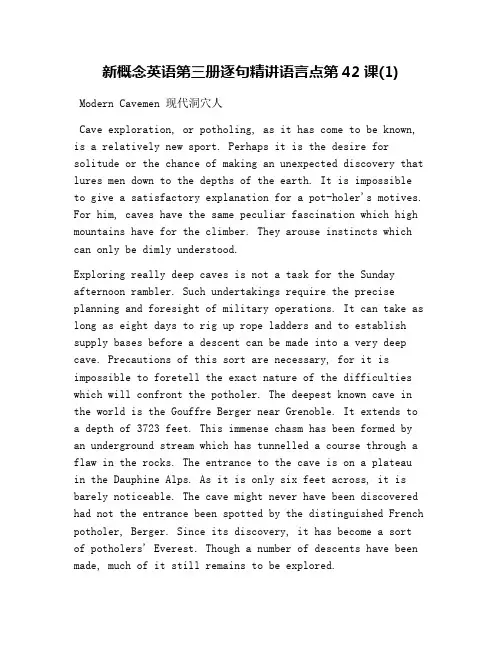
新概念英语第三册逐句精讲语言点第42课(1)Modern Cavemen 现代洞穴人Cave exploration, or potholing, as it has come to be known, is a relatively new sport. Perhaps it is the desire for solitude or the chance of making an unexpected discovery that lures men down to the depths of the earth. It is impossible to give a satisfactory explanation for a pot-holer's motives. For him, caves have the same peculiar fascination which high mountains have for the climber. They arouse instincts which can only be dimly understood.Exploring really deep caves is not a task for the Sunday afternoon rambler. Such undertakings require the precise planning and foresight of military operations. It can take as long as eight days to rig up rope ladders and to establish supply bases before a descent can be made into a very deep cave. Precautions of this sort are necessary, for it is impossible to foretell the exact nature of the difficulties which will confront the potholer. The deepest known cave in the world is the Gouffre Berger near Grenoble. It extends to a depth of 3723 feet. This immense chasm has been formed by an underground stream which has tunnelled a course through a flaw in the rocks. The entrance to the cave is on a plateauin the Dauphine Alps. As it is only six feet across, it is barely noticeable. The cave might never have been discovered had not the entrance been spotted by the distinguished French potholer, Berger. Since its discovery, it has become a sort of potholers' Everest. Though a number of descents have been made, much of it still remains to be explored.A team of potholers recently went down the Gouffre Berger. After entering the narrow gap on the plateau, they climbed down the steep sides of the cave until they came to a narrow corridor. They had to edge their way along this, sometimes wading across shallow streams, or swimming across deep pools. Suddenly they came to a waterfall which dropped into an underground lake at the bottom of the cave. They plunged into the lake, and after loading their gear on an inflatablerubber dinghy, let the current carry them to the other side. To protect themselves from the icy water, they had to wear special rubber suits. At the far end of the lake, they cameto huge piles of rubble which had been washed up by the water. In this part of the cave, they could hear an insistent booming sound which they found was caused by a small water-spout shooting down into a pool from the roof of the cave. Squeezing through a cleft in the rocks, the potholers arrived at an enormous cavern, the size of a huge concert hall. After switching on powerful arc lights, they saw great stalagmites—some of them over forty feet high--rising uplike tree-trunks to meet the stalactites suspended from the roof. Round about, piles of lime-stone glistened in all the colours of the rainbow. In the eerie silence of the cavern,the only sound that could be heard was made by water which dripped continuously from the high dome above them.1.Cave exploration, or potholing, as it has come to be known, is a relatively new sport.洞穴勘查—或洞穴勘探—是一项比较新的体育活动。
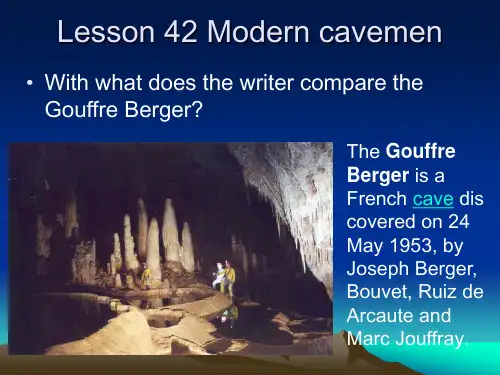
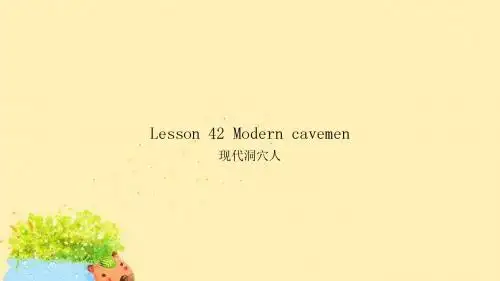
新概念英语第三册笔记第42课上课教案Lesson 42 Modern cavemen一、单词讲解 New words and expressionscaveman n 洞穴人(穴居人)cave n.洞穴(天然的) caveman n. (远古)洞穴人 a man living in a cave thousands of years agocavern ['k?v(?)n] n. 大洞穴,大山洞 a large cavecavity ['k?v?t?] n.洞,腔(正式的医学术语);(龋齿的)洞pothole ['p?th??l] n.锅穴(冰原),壶穴(河床)(地质)potholing n.洞穴探险(运动)potholer n.洞穴探险者solitude ['s?l?tju:d] n.孤独、寂寞(2.独处)(enjoying being alone, being without companions)六级罕见live in solitude 独自(居住)生活isolation n.隔离、孤立(不情愿地,被动)(a feeling of being lonely and unable to meet or speak to other people)eg. Retirement can often cause feeling of isolation.seclusion [s?'klu:?(?)n] n. 隔离(主动,隔离室等);隐居、与世隔绝独处(刻意)eg. The Emperor lived in seclusion behind the walls of the Forbidden City.Recluse [r?'klu:s] n.隐士n. 隐士;隐居者 adj. 隐居的远离【世界】,过着【隔绝】生活,“常常”是【独处】。
- 不一定是【宗·教·信·仰】的原因,不一定是独处(也许是小群体的与世隔绝的生活);recluse的第2个含义,才是指修行者,和上面hermit同。
Modern Cavemen 现代洞⽳⼈Cave exploration, or potholing, as it has come to be known, is a relatively new sport. Perhaps it is the desire for solitude or the chance of making an unexpected discovery that lures men down to the depths of the earth. It is impossible to give a satisfactory explanation for a pot-holer's motives. For him, caves have the same peculiar fascination which high mountains have for the climber. They arouse instincts which can only be dimly understood. Exploring really deep caves is not a task for the Sunday afternoon rambler. Such undertakings require the precise planning and foresight of military operations. It can take as long as eight days to rig up rope ladders and to establish supply bases before a descent can be made into a very deep cave. Precautions of this sort are necessary, for it is impossible to foretell the exact nature of the difficulties which will confront the potholer. The deepest known cave in the world is the Gouffre Berger near Grenoble. It extends to a depth of 3723 feet. This immense chasm has been formed by an underground stream which has tunnelled a course through a flaw in the rocks. The entrance to the cave is on a plateau in the Dauphine Alps. As it is only six feet across, it is barely noticeable. The cave might never have been discovered had not the entrance been spotted by the distinguished French potholer, Berger. Since its discovery, it has become a sort of potholers' Everest. Though a number of descents have been made, much of it still remains to be explored. A team of potholers recently went down the Gouffre Berger. After entering the narrow gap on the plateau, they climbed down the steep sides of the cave until they came to a narrow corridor. They had to edge their way along this, sometimes wading across shallow streams, or swimming across deep pools. Suddenly they came to a waterfall which dropped into an underground lake at the bottom of the cave. They plunged into the lake, and after loading their gear on an inflatable rubber dinghy, let the current carry them to the other side. To protect themselves from the icy water, they had to wear special rubber suits. At the far end of the lake, they came to huge piles of rubble which had been washed up by the water. In this part of the cave, they could hear an insistent booming sound which they found was caused by a small water-spout shooting down into a pool from the roof of the cave. Squeezing through a cleft in the rocks, the potholers arrived at an enormous cavern, the size of a huge concert hall. After switching on powerful arc lights, they saw great stalagmites—some of them over forty feet high--rising up like tree-trunks to meet the stalactites suspended from the roof. Round about, piles of lime-stone glistened in all the colours of the rainbow. In the eerie silence of the cavern, the only sound that could be heard was made by water which dripped continuously from the high dome above them.4.For him, caves have the same peculiar fascination which high mountains have for the climber.对洞⽳探险者来说,洞⽳有⼀种特殊的魅⼒,就像⾼⼭对登⼭者有特殊魅⼒⼀样。